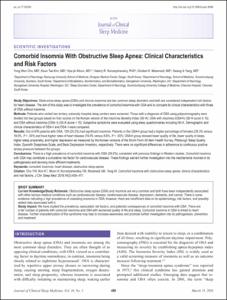Comorbid Insomnia With Obstructive Sleep Apnea: Clinical Characteristics and Risk Factors
- Keimyung Author(s)
- Cho, Yong Won; Kim, Keun Tae; Moon, Hye Jin
- Department
- Dept. of Neurology (신경과학)
- Journal Title
- Journal of Clinical Sleep Medicine
- Issued Date
- 2018
- Volume
- 14
- Issue
- 3
- Abstract
- STUDY OBJECTIVES:
Obstructive sleep apnea (OSA) and chronic insomnia are two common sleep disorders and both are considered independent risk factors for heart disease. The aim of this study was to investigate the prevalence of comorbid insomnia with OSA and to compare its clinical characteristics with those of OSA without insomnia.
METHODS:
Patients who visited two tertiary university hospital sleep centers were screened. Those with a diagnosis of OSA using polysomnography were divided into two groups based on their scores on the Korean version of the Insomnia Severity Index (ISI-K): OSA with insomnia (OSA+I) (ISI-K score ≥ 15) and OSA without insomnia (OSA-I) (ISI-K score < 15). Subjective symptoms were evaluated using sleep questionnaires including ISI-K. Demographic and clinical characteristics of OSA+I and OSA-I were compared.
RESULTS:
Out of 476 patients with OSA, 139 (29.2%) had significant insomnia. Patients in the OSA+I group had a higher percentage of females (35.3% versus 19.6%, P < .001) and have higher rates of heart disease (19.4% versus 8.6%, P < .001). OSA+I group showed lower quality of life, lower quality of sleep, higher sleep propensity, and higher depression as measured by the Korean versions of the Short-Form 36-Item Health Survey, Pittsburgh Sleep Quality Index, Epworth Sleepiness Scale, and Beck Depression Inventory, respectively. There were no significant differences in adherence to continuous positive airway pressure between the groups.
CONCLUSIONS:
There is a high prevalence of comorbid insomnia with OSA (29.2%), consistent with previous findings in Western studies. Comorbid insomnia with OSA may constitute a cumulative risk factor for cardiovascular disease. These findings warrant further investigation into the mechanisms involved in its pathogenesis and devising more efficient treatments.
- Publisher
- School of Medicine (의과대학)
- Citation
- Yong Won Cho et al. (2018). Comorbid Insomnia With Obstructive Sleep Apnea: Clinical Characteristics and Risk Factors. Journal of Clinical Sleep Medicine, 14(3), 409–417. doi: 10.5664/jcsm.6988
- Type
- Article
- ISSN
- 1550-9389
- Appears in Collections:
- 1. School of Medicine (의과대학) > Dept. of Neurology (신경과학)
- 파일 목록
-
-
Download
 oak-2018-0279.pdf
기타 데이터 / 380.21 kB / Adobe PDF
oak-2018-0279.pdf
기타 데이터 / 380.21 kB / Adobe PDF
-
Items in Repository are protected by copyright, with all rights reserved, unless otherwise indicated.